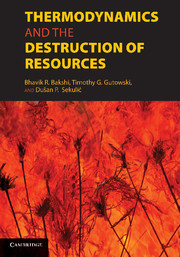Book contents
- Frontmatter
- Contents
- Contributor List
- Foreword by Herman E. Daly
- Foreword by Jan Szargut
- Preface
- Introduction
- PART I FOUNDATIONS
- PART II PRODUCTS AND PROCESSES
- PART III LIFE-CYCLE ASSESSMENTS AND METRICS
- PART IV ECONOMIC SYSTEMS, SOCIAL SYSTEMS, INDUSTRIAL SYSTEMS, AND ECOSYSTEMS
- 14 Early Development of Input–Output Analysis of Energy and Ecologic Systems
- 15 Exergoeconomics and Exergoenvironmental Analysis
- 16 Entropy, Economics, and Policy
- 17 Integration and Segregation in a Population – a Thermodynamicist's View
- 18 Exergy Use in Ecosystem Analysis: Background and Challenges
- 19 Thoughts on the Application of Thermodynamics to the Development of Sustainability Science
- Appendix: Standard Chemical Exergy
- Index
- References
15 - Exergoeconomics and Exergoenvironmental Analysis
Published online by Cambridge University Press: 01 June 2011
- Frontmatter
- Contents
- Contributor List
- Foreword by Herman E. Daly
- Foreword by Jan Szargut
- Preface
- Introduction
- PART I FOUNDATIONS
- PART II PRODUCTS AND PROCESSES
- PART III LIFE-CYCLE ASSESSMENTS AND METRICS
- PART IV ECONOMIC SYSTEMS, SOCIAL SYSTEMS, INDUSTRIAL SYSTEMS, AND ECOSYSTEMS
- 14 Early Development of Input–Output Analysis of Energy and Ecologic Systems
- 15 Exergoeconomics and Exergoenvironmental Analysis
- 16 Entropy, Economics, and Policy
- 17 Integration and Segregation in a Population – a Thermodynamicist's View
- 18 Exergy Use in Ecosystem Analysis: Background and Challenges
- 19 Thoughts on the Application of Thermodynamics to the Development of Sustainability Science
- Appendix: Standard Chemical Exergy
- Index
- References
Summary
Introduction
The objective evaluation and the improvement of an energy-conversion system from the viewpoints of thermodynamics, economics, and environmental impact require a deep understanding of
the real thermodynamic inefficiencies and the processes that caused them,
the costs associated with equipment and thermodynamic inefficiencies as well as the connection between these two important factors, and
possible measures that would improve the efficiency and the cost effectiveness and would reduce the environmental impact of the system being studied.
Exergoeconomics and exergoenvironmental evaluation provide methods for obtaining this information. Because an exergoenvironmental analysis and evaluation are conducted in complete analogy to the exergoeconomic ones, in the following sections more emphasis is placed on exergoeconomics, which has been significantly developed. Exergoeconomics consists of an exergy analysis, an economic analysis, and an exergoeconomic evaluation.
The term exergoeconomics was coined by the author in 1984 [1] to clearly characterize a combination of exergy analysis with economic analysis, when in this combination the exergy-costing principle (Subsection 15.4.1) is used. In this way, a distinction can be made between exergoeconomic methods and applications on one side and other numerous applications on the other side, in which results from a thermodynamic analysis (sometimes including an exergy analysis) and an economic analysis are presented (under the term thermoeconomic analysis) but without applying the exergy-costing principle.
- Type
- Chapter
- Information
- Thermodynamics and the Destruction of Resources , pp. 377 - 401Publisher: Cambridge University PressPrint publication year: 2011
References
- 20
- Cited by

